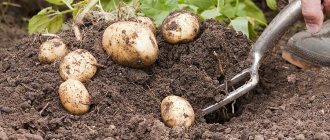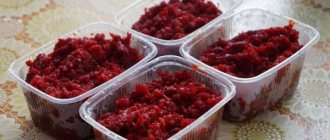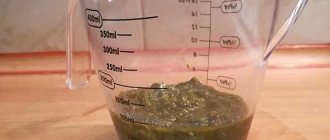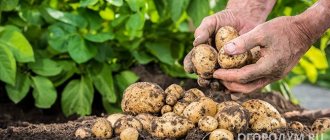Potatoes are a traditional vegetable for Russians. It is grown in almost every garden, and with the arrival of autumn it is put into bins for long-term winter storage. But unfortunately, potato tubers often turn black during storage. And even seemingly healthy vegetables may have black spots when cut. Why potatoes turn black during storage remains a mystery for many farmers that must be solved. Otherwise, the problem will arise year after year, destroying kilograms and tons of harvested crops.
Why do potatoes turn black?
There are many reasons for the appearance of blackened pulp inside potatoes and they can all have a different nature of origin. These include:
- the presence of polyphenols and polysaccharides in the vegetable;
- lack of potassium;
- excess phosphorus;
- viral, bacterial and fungal diseases;
- failure to comply with storage conditions.
All of these factors can influence the appearance of dark flesh. But in order to understand in detail the reasons for this phenomenon, it is necessary to consider the type of darkening and at what moment it was noticed.
After cooking
If before heat treatment the potato tubers had a normal appearance, and after cooking the vegetable acquires a uniform bluish or dark tint, there may be several reasons:
- This potato variety contains a large amount of dry matter, in particular starch. They are actively used for making chips: “Red Scarlett”, “Rosara”, “Lady Claire”, “Nadezhda”, etc.;
- When growing potatoes, the soil was poor in potassium or, conversely, there was an excess of phosphorus fertilizers.
In addition to starch, which is a polysaccharide, potatoes contain polyphenols. When interacting with oxygen or under the influence of high temperatures, these substances react, which is also an answer to why boiled potatoes turn black.
The same reaction is observed if the potatoes were grown on soil with a lack of potassium or the producer overdid it with the addition of phosphorus fertilizers.
If there is an excess or deficiency of microelements, the amino acid balance of the plant changes, which ultimately leads to the fact that, due to the chemical reactions that occur, the potatoes turn black when cooked.
During storage
There are also many reasons for the appearance of dark spots during crop storage, but they can all be divided into 3 main groups. The main reasons why potatoes turn black inside during storage include:
- violation of harvesting technology;
- failure to comply with storage conditions;
- presence of diseases.
of harvesting technology include harvesting either too early or too late. When harvested early, young tubers do not have time to form a thick skin, which protects the potatoes from bacteria and pests. Moreover, the tubers do not have time to accumulate substances responsible for protective functions. All this leads to infection of the tubers with various diseases and their blackening.
Late harvesting after frost leads to “frostbite” of vegetables. As a protective reaction, polysaccharides begin to decompose in the tubers, which softens the pulp and leads to blackening - oxidation. The same effect is observed when storage conditions are violated . Potatoes become soft and turn black if:
- if the temperature was below +2 and above +5°C;
- air humidity in the vegetable storage is over 80%;
- there was no ventilation in the cellar.
Another reason why tubers turn black is the storage of damaged vegetables . At first glance, the potatoes may be intact, but during the process of planting or transportation, the tubers often hit each other hard. As a result, the potatoes receive microtraumas, polysaccharides react and the tubers darken.
Another common reason why potatoes turn black inside is the presence of diseases . The spots inside can have different appearances, by which you can identify it:
- black leg - a hollow, black-brown notch is visible on the section of the tuber. Sometimes you might think that this is the activity of some pest, but in fact it is a bacterial disease that is difficult to treat;
- Late blight is a fungal disease. The tubers have a black, uneven color.
Many signs of the presence of a disease in a crop can be noticed even at the growing season: weak tops, brown spots on the leaves, black rot near the roots. Such products will not last until spring, so there is no point in storing them in the cellar.
After cleaning
Discoloration after cleaning is a natural phenomenon . It's all about the same polyphenols contained in potatoes. Under normal conditions, substances practically do not interact with each other and oxygen, but everything changes with mechanical damage.
During the cleaning process, the intercellular membranes that separate the substances are destroyed and, as a result, a chemical reaction begins. The same processes occur during heat treatment. It is for this reason that it is recommended to immerse the potatoes in cold water after peeling - this allows you to stop the oxidation reaction.
What to do if the potatoes are black inside
Various methods are used to resolve the problem.
It is important to determine the cause and type of disease
Disease Control
Having discovered the first signs of blackening on potatoes, the plants are treated with fungicides. The most commonly used are Bordeaux mixture and copper sulfate (5–10 g per 10 liters of water).
The culture is also treated with biological preparations - Baktofit, Alirin-B, Binal, Pralin. They can be used up to five times per season. Unearthed plants need to be sprayed.
Along with store-bought drugs, folk remedies for combating blackening are also popular. Treatment is carried out every 10-15 days from the moment the sprouts appear.
Traditional methods:
- Treat the plants with wood ash, which is infused by pouring 4 handfuls of 10 liters of boiling water. A day later, water the potatoes with this solution.
- The garlic cloves and arrows are crushed. 150 g of raw material should be filled with 200 ml of water, which should be warm. Leave for 3 days, then strain, add 10 liters of water and 0.5 g of potassium permanganate. Use for spraying and watering.
- Finely chop the leaves and roots of horsetail (1.5–2 kg). Fill with water in an amount of 10 liters. Leave for 3 to 5 days, strain.
For blackening, Trichopolum tablets are also used (one for every liter of water). Treat plantings at intervals of 15–20 days.
Blackleg
There are measures to combat pathology and prevent it that have been tested over the years:
Plant carefully rechecked seeds. Pay special attention to crop rotation. In case of soil contamination, it is not recommended to plant potatoes in this area for 3-4 years. The pathogen loves moist clay soil
The acid contained in its composition can neutralize dolomite powder. It destroys bacteria and fungi very well. Microorganisms cannot tolerate sulfur. If the bottom of the stems turns black, the plant is infected. Treatment with ammonium sulfate is recommended. The drug Effekon is effective for treatment at a dose of 3 tbsp. l. for 10 liters of warm water. Carry out the treatment before the first hilling.
Attention! The causative agent of the disease is carried by almost all insect pests of potatoes - the Colorado potato beetle, plant louse, grasshopper, click beetle. For this reason, they also need to be dealt with.
Late blight
It is possible to reduce the incidence rate by growing resistant varieties:
- September;
- Russian souvenir;
- Luck;
- Belorussky 3;
- Canteen 19;
- Pace.
Note: Phytophthora mushrooms do not attack potatoes near which mustard grows. You can first sow it on the plot, and when shoots appear, dig up the soil and plant potatoes.
Adding mineral fertilizers to the soil has a positive effect. Potassium and phosphate compounds are especially effective. And finally, the use of chemicals will thoroughly protect the culture from infection. Examples - Ridomil, Onyx.
Melanosis
To exclude this disease, you must:
- maintain the correct balance of fertilizer application;
- harvest in a timely manner;
- transport root crops carefully without injuring them;
- Before storing in storage, observe a “healing” interval; at this moment, the peel hardens and the wounds grow together.
Organizing proper care
List of rules:
- Boxes with vegetables should be moved 20 cm away from the walls. This way the potatoes will not get wet and freeze.
- Vegetables should be stored in containers with holes for ventilation.
- You can put beets on top of the potatoes so that they absorb excess moisture.
- During storage, sort through the crop 2-3 times to remove rotten and diseased vegetables.
Help Potatoes that have darkened due to freezing or mechanical damage are not considered harmful for consumption. But it’s already difficult to call it healthy and tasty.
What to do to prevent potatoes from turning black
To avoid blackening of tubers, you can use various folk and agrotechnical methods.
When cooking
To prevent boiled potatoes from acquiring a dark color, you can turn to folk tricks. During cooking, add to the water:
- a small pinch of citric acid;
- a couple of drops of vinegar;
- Bay leaf.
These components will help stop the oxidation reaction of polysaccharides. Soaking the peeled product in cold water for an hour before boiling or frying also helps.
If the product is used to prepare potato salads, then after boiling and cooling, it is also recommended to place the tubers in water with the addition of citric acid for several minutes. This way boiled potatoes will retain their appetizing appearance.
During storage
To prevent the tubers from darkening in the cellar, you must adhere to the following rules:
- place only whole, healthy, well-dried material in storage;
- observe the temperature regime - the optimal temperature for preserving vegetables is from +2 to +5°C;
- regularly ventilate the storage;
- prevent damage to the crop by pests: mice, slugs, etc.
The product can be stored in an already cleaned form. There are several recommendations here. The most common option is in a pan of water in the refrigerator. This way, potatoes can be safely stored for no more than a day and can be used to prepare various dishes.
Alternatively, the tubers can be chopped, placed in a bag and stored in the freezer for several weeks or until first defrosted.
After cutting, the product should be placed in the freezer immediately so that it does not have time to turn black in the air.
Let's figure out why potatoes darken and how to prevent blackness from appearing in tubers
Potatoes are one of the products that most people are accustomed to seeing on their table several times a week, or even daily.
Many grow it on their plots, others buy it as needed. Quite often, root vegetables quickly darken, losing their attractiveness and taste. Tuber spoiled by rot
Many people ask why potatoes inside are empty and brown, or even black, and what to do to prevent them from turning dark. Let's look at the reasons
It is important to know why potatoes turn black inside at the stage of growing, storing, and cooking, as this can be dangerous for humans
- Reasons for darkening of potatoes after peeling Methods for storing peeled potatoes
- How to Keep Peeled Potatoes White
- Infectious diseases and tuber damage
Methods for storing peeled potatoes
Sometimes housewives are faced with the problem of preserving tubers after cleaning.
To prevent the potatoes from turning black inside, use the following options:
Freezing. Potato slices are placed in a bag and placed in the freezer. There they can be stored for a couple of months or until the first defrosting. First, the pieces are placed individually on a tray or board and placed in the freezer.
When the slices are frozen, carefully remove them from the board and transfer them to a bag or plastic container and put them back in the freezer. This prevents the pieces from sticking together
They are prepared without first defrosting, otherwise everything will turn into jelly.
Cold water. Place the peeled potatoes in a container with water and put them in the refrigerator. It will not turn black, will not turn blue, and will be suitable for cooking within 24 hours.
How to Keep Peeled Potatoes White
It is quite possible to keep potato slices, whole or grated tubers light and not blackened.
There are several ways:
- Water. To prevent potatoes from darkening after peeling, they are immediately placed in cool, salted or acidified water. Soaking peeled root vegetables in cold water for an hour will keep them fresh and free of black spots. Boiled potatoes are preserved in the same way. After cooking and cooling, it is recommended to place it in cool, acidified water. The tubers will remain appetizing and attractive.
- Acidification. When cooking or stewing, add a little apple cider vinegar, bay leaf, a couple of grams of citric acid or a spoonful of lemon juice. These components stop oxidative reactions in potato pulp.
- Blanching. To preserve potato slices, immerse them in boiling water for 4 minutes (blanch). This will destroy the tyrosinase and the potatoes will remain light in color. Then they put it in a bag and freeze it or simply put it on the refrigerator shelf (but must be used within 48 hours).
Adverse weather conditions
Potatoes, despite their apparent unpretentiousness, prefer to grow and ripen at average temperatures and humidity. Deviations in these parameters provoke blackening of the tubers. A lack of moisture leads to their drying out, and an excess leads to a lack of oxygen and rotting.
Fungal diseases of potatoes
Fungal spores are spread by wind, insects, and water. Under favorable conditions (cold weather and high humidity), fungi begin to actively multiply, spreading over large areas.
The potatoes have turned green
Green potatoes are often a sign that a large amount of the alkaloid solanine has accumulated in the tuber (sunlight promotes its accumulation). This substance is poisonous, so affected tubers will have to be disposed of. If the greening is small, the damaged areas of the tuber can be cut off with a knife.
Preventive measures: to protect the tubers from sunlight, in the summer months potato bushes are hilled to a height of 15-20 cm. For the same reason, the crop should be stored in a dark room.
Can it be eaten?
If the potatoes have turned black, this does not mean that they have become less healthy and cannot be cooked. Often this is a natural process or minor disturbances during transportation or storage. These reasons do not cause any harm to the human body.
However, if the potatoes have darkened as a result of the development of a bacterial or fungal disease, it is better to discard the product. During their life processes, microorganisms release toxins that are not destroyed even after heat treatment.
Causes of blackening of potatoes
The appearance of dark spots under the skin of potatoes can be caused by various reasons. In each case, you need to understand thoroughly, identify the source of the blackening and try to eliminate it if possible.
During storage
If you find darkened potatoes in storage, you must promptly remove them from a common box or chest. Color changes are caused by:
- storage for frozen tubers. This usually happens during late harvesting, when the potatoes are “grabbed” by the first frost. The pulp softens, oxidizes, and dark spots appear on it;
- storage of young potatoes. Tubers dug up ahead of schedule did not develop a thick, durable skin. It protects the pulp from mechanical damage and pathogenic fungi;
- improper storage conditions for vegetables (too low or high temperature in the cellar, high humidity, lack of ventilation);
- storage of infected tubers (during harvesting into the cellar, no sorting or inspection of the potatoes was carried out).
On a note! If the potato tops have an infection during the growing season, for example, late blight, then the tubers cannot be stored.
- mechanical damage. When harvesting potatoes or transporting some of the tubers, they were broken and slightly cut. All these damages lead to blackening of the potato pulp. Moreover, potatoes with deformations are more often affected by various fungi and bacteria and rot.
After cleaning
To prepare most dishes, potatoes (unless you plan to bake or boil them in their jackets) must be peeled. “Stripped” tubers quickly darken, and the beautiful flesh takes on an unattractive grayish or bluish-black hue (see photo).
Why do potatoes turn dark after peeling? The culprits of darkening are the amino acid tyrosine and the special enzyme tyrosinase present in potato pulp. They are necessary for oxidative processes, and upon contact with oxygen they cause darkening. This is why peeled potatoes quickly turn black.
The amount of tyrosinase depends on nitrogen fertilizing. Therefore, if the plants in the garden were “overfed” with organic matter or mineral nitrogen fertilizers, the potatoes peeled for food will darken instantly (up to 2-4 minutes). With this kind of indicator, you can “by eye” determine nitrate potatoes, since they quickly darken when cut.
After cooking
Often housewives are faced with the fact that snow-white potatoes after peeling take on a gray or dark appearance after cooking. Causes:
- poor quality water;
- feature of the variety (starchy varieties containing a large amount of dry matter most often darken);
On a note! Potato varieties with high starch content: Odyssey, Impala, Skazka, Skarb, Charodey, Red Lady, Red Scarlet.
- when growing crops, agrotechnical practices were violated (excess of phosphorus and nitrogen additives, deficiency of potassium fertilizers in the soil);
- storage rules are not followed (high humidity, low amount of oxygen in the cellar);
- freezing of vegetables. Frozen potatoes soften, darken after cooking, and acquire a sweetish taste.
Is it possible to eat it? It is possible, since in this case there is no infection, the tubers are not diseased and there is no danger to human health. True, the taste of boiled potatoes will be unusual, and external attractiveness is also important.
The main causes of browning of potatoes (gray spotting)
- 1. Lack of potassium in the soil or excess nitrogen during potato growing. For example, they brought in a lot of fresh manure, mown green grass, buckwheat husks, or dug up the ground with a large harvest of sederats and planted potatoes the same year. Potatoes do not like fresh organic matter because too much nitrogen is released and an abundance of fungi accumulates during its decomposition. As a result, the tubers are affected by scab, and dark spots appear on the pulp during storage. Organic matter is extremely necessary for potatoes, but not fresh but rotted, 1-2 years after application.
- 2. When forming tubers, both lack of moisture and waterlogging are dangerous. If there is a lack of moisture, the tubers overheat in dry, hot soil, and if overmoistened, they suffocate from lack of oxygen.
- 3. Untimely harvesting. Early harvesting of unripe tubers leads to darkening of the pulp. And vice versa, if the potatoes are ripe, the tops naturally dry out or are mowed, and harvesting is delayed, then in warm sunny weather the tubers remain in dry, heated soil for a long time and overheat. Potatoes can spoil if stored in bags for a long time without refrigeration. After excavation, they were not cooled and stored without ventilation. 2-3 months after such harvesting, gray spots appear in the pulp. Potatoes are also “steamed” if, after digging, they are stored for a long time in bags without refrigeration.
- 4. Harvesting too late with the onset of light frosts is dangerous. In cold soil, the tubers become supercooled. and during storage the pulp darkens. It is important to know that at soil temperatures of minus 1.5 - minus 1.7 degrees, tubers freeze and rot during storage as wet rot.
- 5. An important reason for the appearance of gray spotting is bruises and compression of tubers during harvesting, packaging in any container and transportation to their destination.
- 7. A possible reason could be that the selected variety contains too much starch. Such varieties more often suffer from gray spotting.
- 8. Potatoes are often affected by an infectious disease - black leg. The disease is transmitted by infected mother tubers. From a diseased bush we get diseased tubers of varying degrees of damage. The disease continues to develop in the storage facility. The disease is different from gray spotting. The tuber turns black from stalon. The blackness covers the entire heart-shaped part up to the vascular ring, and then the entire tuber rots, emitting an unpleasant smell of rot. During growth, diseased bushes differ from healthy ones. They need to be seen in time, dug up along with the tubers and removed from the field before the main harvest.
How to avoid browning of potatoes
What should I do to ensure that in any situation (cooking, storage) the potatoes do not turn black and lose their taste? Let's start with the fact that it is necessary to follow the rules of agricultural technology.
Recommendations for growing potatoes
It is recommended to grow different potatoes on the site:
- early-ripening and mid-ripening (in the south they add late-ripening, which manages to ripen before the onset of cold weather);
- with high and medium starch content (the first is suitable for purees, baking, making chips, pancakes, the second - for soups, frying, salads).
It is advisable to select zoned varieties that are resistant to infections and are less susceptible to attacks by pests. Further:
- maintain the timing of planting and harvesting crops, taking into account the weather and climate of the area;
- comply with fertilizer application standards without overusing nitrogen;
- during dry seasons, provide regular irrigation to the plantings;
- exclude chlorine from fertilizing;
- be sure to carry out preventive treatments against diseases and insect attacks;
- alternate crops on the site;
- use healthy seed material for planting.
Rules for storing vegetables
After digging, carefully dry the potatoes in the open air or under a canopy, sort them, removing diseased and damaged tubers.
On a note! Be sure to burn infected tops and tubers without using them for composting.
Seeds and potatoes for food are stored separately, regularly checking the supply of vegetables. In the cellar, a comfortable regime for tuber crops is provided:
- humidity – 80-85%
- air temperature: +3ºC…+5ºC.
Store the tubers in the dark. They are distributed according to shelf life: early potatoes are eaten in summer and autumn, mid-season and late potatoes are used for food in winter and spring. The storage facility must be disinfected and storage containers (bags, nets, chests, wooden lattice boxes) must be prepared in advance. When stored in bulk, the layer of tubers should not exceed 80-100 cm.
Infected potatoes cannot be stored. It is discarded and burned. Beets are suitable as “neighbors” in the cellar for potatoes; it is advisable to separate other vegetables.
Useful tips for housewives
The very first thing: before cooking, potatoes must be washed in running water, removing dirt and possible chemical residues from the skin (especially from store-bought vegetables). To prevent the potatoes from turning black after peeling, they are immersed in cold water. For high-starch varieties, a couple of drops of citric acid will serve as a preservative; water will remove excess starch from the surface of the vegetable.
Before adding to soup or cooking, the water in which the potatoes were is drained. When cooking a vegetable, the liquid must completely cover the potatoes, otherwise a grayish coating will appear on the upper parts. Instead of citric acid, you can add bay leaf to the water; it also protects the pulp from blackening.
When boiling potatoes in their jackets, wash the tubers thoroughly with a brush, then place them in a saucepan and fill completely with cold water. Add a teaspoon of salt, cover with a lid and bring to a boil. Then reduce the temperature and cook over low heat until tender. It is tastier to bake a vegetable in its jacket in the oven, then more vitamins and nutrients are retained in the pulp.
We hope that the information about why potatoes turn black in different situations will be useful. Follow simple techniques and rules, take into account the characteristics of the varieties - and you will never have problems with storing and preparing this tasty vegetable.
How to freeze raw potatoes
Peeled, smooth potatoes without eyes and with the least amount of starch are suitable for freezing. Pink-skinned varieties store especially well. The temperature in the freezer should be above 18 degrees.
If potatoes become sulfitated, they are stored in the freezer for 2 days at a temperature of 2-6 degrees. There are several ways to freeze raw potatoes:
- Entirely. Small tubers are washed and blanched for 5 minutes. After this, the potatoes are cooled in cold water and placed in vacuum bags. Large potatoes are cut into medium pieces and frozen using the same method.
- In pieces. The peeled tubers are cut into bars, washed and dipped in boiling water for 2-3 minutes. They are then cooled in cool water and placed on a dry towel to dry. The potato pieces are placed in bags and tied so that there is no air left in them.
To avoid potatoes sticking together, the product is frozen in several stages. It is laid out in one layer on a tray and kept in the chamber until frozen, and then packaged in bags.
Before cooking, potatoes are not defrosted, but used immediately for cooking. The result largely depends on the power of the freezer, the variety of tubers and the skill of the housewife. If you do everything according to the instructions, the vegetable will hardly change its taste, structure and color. It is recommended to freeze a small batch of potatoes to check how they behave after such storage.
Do you use expired food for cooking at home? Yes, the main thing is to process it if it is meat or expired kefir for pancakes. 27.71%
No, it is very dangerous and not useful. 37.66%
If the products have fungus or mold, then we throw them away; if they are a couple of days past their expiration date, we use them for food, even without heat or other treatment. 34.63% Voted: 693
Turned black when growing
Why potatoes may turn black inside during the growing stage:
- Too much nitrogen in the soil, or potassium deficiency. Also, undiluted organic matter added to the soil can cause darkening of the pulp; potatoes do not like the introduction of concentrated products;
- During cultivation, mistakes were made in watering; this could be either overwatering or underwatering;
- The harvest was harvested either too early or, conversely, late. In the first case, the tubers simply do not have time to ripen; in the second, they spend too long in the warm soil and rot.
Blackening during storage
Quite often potatoes turn black inside during storage, let’s find out why this happens:
- Potatoes become covered with dark spots when they are kept in a warm place for a long time or in a room with insufficient ventilation. Typically, the first manifestations appear after 1-2 months of improper storage;
- The normal storage temperature for potatoes is considered to be a range from 2 to 4 degrees with a plus mark; if the temperature is lower, the vegetable freezes; if higher, dark spots may appear.
In addition, it is worth saying that blackening of the pulp can occur due to the fact that you planted a variety that contains too much starch. The fact is that it is these varieties that suffer from this problem, most often this manifests itself during cooking of the vegetable.
Storage rules
How long the potatoes will last depends on proper preparation for storage and the conditions in the cellar itself. The choice of variety when planting also influences. The main factors that must be taken into account for the safety of the crop:
- When planting, you need to think about which varieties you will need, because they are stored differently. Late potatoes are intended for long-term storage in the cellar. Even under ideal conditions, early varieties will not last long. They are intended to be eaten directly during the season.
- Before being sent for storage, the tubers are sorted and sorted - diseased, damaged, and suspicious ones are removed. Potatoes that come into contact with diseased vegetables should also be removed; they may be infected, but symptoms have not yet appeared. Even a few diseased tubers can destroy the entire crop in storage. Potatoes must be dried, otherwise raw tubers may turn black inside and rot.
- Constant monitoring of the temperature in the place where the crop is stored is necessary. Special control is needed during the changing seasons in autumn and winter, when there is a risk of temperature fluctuations.
Important! Some potato varieties contain a lot of starch and a slight browning is normal for them.
To maintain the desired air temperature in the storage room, use ventilation and bottles of cold or hot water placed around the perimeter of the cellar. This reduces the risk that the vegetable will begin to turn black inside. With timely control of humidity and temperature, potatoes can be preserved.
Blackening due to crop diseases
As mentioned earlier, the appearance of dark spots can be caused by one or another disease, let’s find out why potatoes can turn black inside, what diseases contribute to this:
Blackleg
This is an infectious disease that is transmitted from an infected tuber to a healthy one. Moreover, further spread of the disease can occur in the bags, when the potato crop has already been harvested and the fields are empty. Externally, this condition can be distinguished from gray spotting, because from the inside the tuber will turn black from the stalon. Black spots initially cover the middle of the potato, later moving to the vascular branches, appearing on the peel. Also a distinctive characteristic of the disease is a characteristic unpleasant putrefactive odor. It is important to detect the problem early during the growing stage to prevent the spread of the disease.
Melanosis
Next we will talk about a disease such as melanosis. Externally, the tuber and peel of the affected crop will look normal, without changes, but at this moment the blackness continues to increase under the peel. It is worth saying that the affected vegetables remain suitable for food, which cannot be said about the previous disease - blackleg. To ensure that the stains do not increase in size and the prepared dish looks more or less attractive and appetizing, you need to add vinegar and citric acid to the water during cooking; it is not necessary to peel the peel.
The reasons for the appearance of melanotic spots can be different, for example, mechanical damage to the vegetable.
Potato varieties with a high starch content in the pulp most often suffer from melanosis; it becomes dark more often than others. In addition, the development of the disease is accompanied by errors in choosing the harvest time. It is worth taking this aspect wisely, and also doing everything to avoid injuring the tubers during harvesting.
The cause of the disease can be high humidity
An excellent prevention of melanosis is placing beets in potato bags; it helps keep the potato pulp intact. The fact is that beet will help overcome the problem of excessive humidity in the place where tubers are stored.
Late blight
Another reason for the appearance of such spots on the pulp may be late blight. This disease occurs in any region, including the entire territory of Russia. A distinctive feature of the disease is that it affects not only the tuber, but the leaves of the plant. This fact greatly complicates pest control. If preventive measures are not taken in time, there is a possibility that the fungus can infect all plants and crops growing in the garden or field.
Signs of late blight
- Brownish spots and dots form on the leaves
- The leaves rot and then dry out
- The final stage is their fall
Causes of late blight
Infection with late blight occurs as follows and for the following reasons:
- Remains of weeds and other vegetation were not removed in time
- The seedlings were initially infected with a fungus
- Mistakes were made in the technology of growing potatoes.
It is worth saying that the scale of late blight damage is impressive; the disease spreads very quickly. The peak incidence occurs during the flowering period of the bush, although in most cases the period of infection can shift in one direction or another depending on weather conditions. The most favorable time for the reproduction and spread of the fungus is wet and damp weather - rainy autumn or thaw in spring. In addition, the spread of infection will be facilitated by excessive watering of potato bushes, thus, pathogenic microflora will move along with moisture through the soil. It is worth saying that, despite the fact that late blight itself poses a danger to the future harvest, the disease also significantly increases the chances of infection with other ailments, for example, various fungal diseases or wet rot.
Prevention of late blight
In order to preserve and protect your crop from late blight, you need to know all the preventive measures, because they are quite simple, in contrast to getting rid of the disease, which involves getting rid of infected bushes. We will try to list the main preventive measures that every farmer should know:
- Do not cover the harvested potatoes with tops. If there are infected leaves, there is a risk that the disease will soon spread to the tubers
- Harvest depending on the potato variety. So, earlier varieties should be dug up earlier, without waiting for the thickness of the peel, while later varieties should be dug up later.
- Follow watering norms and do not forget to add fertilizers to the soil on time.
How to protect potatoes from rotting?
Based on all of the above, it is clear that the poor preservation of tubers during the cold period begins with a violation of the technology for growing and harvesting this crop. The following significant reasons are the unpreparedness of the storage facility (cellar, basement, vegetable pit, balcony, loggia, etc.) for storing products, incorrect selection of potato varieties, and violations of storage technology.
It is these reasons that cause damage to tubers by various fungal, mold and bacterial diseases; contribute to their rapid spread and loss of yield not only during cultivation, but also during storage.
To protect potatoes from rotting during storage, it is necessary to properly prepare the area for this crop. Apply fertilizers, fertilize, treat diseases and pests only in accordance with technology and recommendations.
For planting (for the purpose of long-term storage of tubers during the cold period), it is necessary to use only zoned, medium and late varieties (in terms of ripening), resistant to fungal and other diseases. Before planting, the seed material must be processed.
During the growing season, plant treatment must be carried out at the very beginning of the disease, and not wait for mass damage. It is more practical to carry out preventive treatments according to a previously worked out scheme.
Only absolutely healthy, undamaged tubers should be stored in prepared storage facilities.
Fulfilling the basic requirements for preparing tubers, planting them, caring for them and harvesting them will minimize damage to the crop during winter storage.
When planting several varieties on a site, each is harvested separately
Rules for protecting potato tubers from rotting during storage
- When planting several varieties on a site, each is harvested separately.
- Only mid-season, mid-late and late potato varieties are stored for storage. Early varieties after December are no longer suitable for use as food and remain as planting material or are used for animal feed.
- In order for the tubers to ripen well, the potato tops are mowed 10-15 days before harvesting.
- Potatoes are dug up in dry, sunny weather. If the weather is rainy, then the potatoes are slightly dried and manually cleaned of adhering dirt (to avoid mechanical damage through which a fungal or bacterial infection can penetrate inside the tuber).
- Mechanically damaged and diseased tubers are immediately put into a separate pile.
- Healthy, undamaged potatoes are transferred under a canopy (covered from the sun) or in a dark room with good ventilation for 5-7 days to ripen (coarse) the upper skin. Protection from light is necessary to prevent the potatoes from turning green. Solanine is formed in light, and such tubers cannot be used as food.
- Before storing, the storage facility is disinfected and dried.
- To protect against rotting during storage, dried and cleaned tubers can be treated with the biological preparations “Fitosporin” and “Anti-rot”, which will reduce the infectious background. They are harmless to humans and animals.
- If potatoes are stored in bulk, then it is advisable to place 1-2 rows of beets on top. It will absorb excess moisture, which will protect the potato tubers from rotting. The beets will not be harmed.
- It is more advisable to store potatoes in boxes (each variety separately).
- Once a month, the tubers are sorted, removing the diseased ones.
- Good ventilation will protect stored products from infection and rotting.
- The air temperature in the storage must be maintained at +2...+4°C, and humidity 80-91%. If the humidity in the room is high, you can place, in addition to ventilation, a container of quicklime and change the filler if necessary. With the arrival of spring, the temperature in the storage room may rise. Frozen water in plastic bottles with a capacity of 3-5 liters will help reduce it. Ice containers are placed in different places. Ice in closed containers will gradually melt and cool the room.
Fighting methods
What to do if, despite all preventive measures and sufficient care, the potato tops still turn black? In this case, you need to put all your efforts into overcoming the disease as quickly as possible, before the problem becomes more global. If you find slight blackening of the leaves on a potato bush, take the following measures:
- Spray potato leaves with Bordeaux mixture or copper oxide with chlorine; a seven-day treatment is usually enough to solve the problem of blackening of potatoes once and for all. In this case, each sheet is processed, and this must be done on both sides.
- If you discover the disease at an advanced stage, that is, the potato bush has turned pretty black, there is not a single green leaf left on it, there is no point in saving it.
- After all of the above steps have been carried out, it is necessary to mow and then destroy all the tops that have been affected by the disease, and this is done strictly 7 days before harvesting.
- After the crop is harvested, it is important to ensure normal storage conditions for the crop, that is, to comply with the requirements regarding ventilation, temperature and lighting. It is important to re-check the crop after 2-3 weeks of storage to eliminate black tubers.
How to properly cook potatoes so they don't darken
To prevent potatoes from changing color during cooking, you should thoroughly peel the vegetable. To begin with, you should thoroughly wash the tubers, so that dirt and residues of chemical fertilizers do not get on the pulp. You need to peel until the pulp is light, leaving no greens or traces of peel.
Immediately after peeling, the potatoes are stored in a container with cool water. Lack of contact with oxygen inhibits physical and chemical processes. Before cooking, the workpiece is washed well again under running water.
Reference! Ignoring sanitation standards when preparing potatoes for cooking provokes not only a decrease in the aesthetic and taste qualities of the vegetable. Remaining chemical particles pose a health hazard.
In the process of preparing root vegetables for cooking and directly during heat treatment, it is important to ensure that the potatoes are completely immersed in water. If the workpiece is not immediately placed on the fire, then the water in which the potatoes settled must be replaced.
Experienced chefs add bay leaves to the pan when cooking. This trick helps prevent black spots from appearing on the flesh.
Why do potatoes turn black inside during storage?
Potatoes are a traditional vegetable for Russians. It is grown in almost every garden, and with the arrival of autumn it is put into bins for long-term winter storage. But unfortunately, potato tubers often turn black during storage. And even seemingly healthy vegetables may have black spots when cut. Why potatoes turn black during storage remains a mystery for many farmers that must be solved. Otherwise, the problem will arise year after year, destroying kilograms and tons of harvested crops.
Reasons why potatoes turn dark
There are several factors that provoke darkening of color after heat treatment of root vegetables. In addition, the reasons are not always related to errors in cooking technology. Most of them are allowed during the process of growing and storing potatoes.
- Potassium deficiency in the soil where the tubers grow. It is recommended to use high-quality fertilizers produced by a trusted manufacturer.
- High chlorine content in the soil. The chemical penetrates the pulp, changing the structure of the vegetable. As a result, the root crop is large in volume, but watery and soft.
- Excessive use of nitrogen fertilizers. The active substance promotes the accumulation of amino acids (including tyrosine) inside the pulp, which provokes the formation of spots.
- Inaccurate harvesting. When a vegetable is struck or transported harshly, its structure is disrupted. The result is blackening of the deformed areas after cleaning or cooking.
- Violation of the temperature regime during potato storage. Indicators below +1° are considered dangerous for root crops. A frozen vegetable loses its color even after cleaning.
- Loading potatoes immediately after digging into storage. The harvested crop must first dry well, after which it is sent to a cool place for gradual cooling. Only when frost occurs is the workpiece transferred for wintering to cellars or other specially equipped rooms.
- Lack of oxygen in winter storage. The problem is solved by installing a ventilation system.
- High humidity in the cellar or other storage for vegetables. In a humid environment, mold actively develops, which destroys oxygen. Periodically, it is necessary to carry out an inspection of the cellar in order to eliminate any problems that have arisen. Wet tubers need to be dried well, separating them from the general harvest.
Why are there dark spots on potatoes (grey rot)
In the cross-section of some tubers you can see blackening of the pulp. An example of such a change is shown in the photo above. This defect is a sign of gray rot of tubers. It can occur due to a number of reasons. As a rule, they are associated with a violation of the storage or transportation regime of vegetables. Experts identify 6 main reasons why potatoes turn black inside during storage:
Unbalanced soil composition
Many gardeners, in an effort to get a good harvest of vegetables, add large amounts of organic matter to the soil. This can be manure, herbal infusion or green manure. Such fertilizers contain a large amount of nitrogen, which accelerates plant growth and allows you to increase the mass of tubers. However, it is the large amount of nitrogen that is the main reason why potato tubers turn black during storage.
This cause can be eliminated through proper application of fertilizers:
- Fresh organic matter cannot be used for potatoes. It should be well rotted. This applies not only to manure, but also to green manure.
- Adding manure to the soil for growing potatoes is allowed no more than once every 2 years.
Focusing on the use of nitrogen, many gardeners forget about such an important trace element as potassium. But it is potassium that allows the tubers to ripen in a timely manner and be safely stored during the winter. So, to prevent blackening of tubers, it is necessary to regularly add potassium fertilizers to the soil.
Weather features
Potatoes prefer to grow in conditions with moderate temperature and humidity. Fluctuations in these indicators negatively affect the quality of tubers:
- high temperature leads to overheating of tubers;
- low temperatures slow down the process of nutrient absorption from the soil, resulting in the formation of small vegetables;
- lack of moisture dries out the tubers;
- Excess moisture does not allow potatoes to breathe oxygen to the required extent, as a result of which various fungal and bacterial diseases and rot develop.
Each of these unfavorable conditions and their complex can lead to the fact that potatoes during storage begin to turn black inside and lose their consumer qualities.
Late cleaning
Potatoes must be harvested from the field on time. Every experienced farmer knows this rule. Harvesting an unripe crop and harvesting potatoes with the onset of frost can lead to dire consequences during storage:
- Harvesting must be carried out in accordance with the characteristics of the variety. Harvesting unripe tubers too early will most likely lead to blackening of the potatoes during storage;
- Potatoes must be collected from the fields before the first frost. Temperatures of even -1 0 C can lead to freezing of the crop, as a result of which it will rot during storage;
- In warm sunny weather, potatoes cannot be stored in the soil for a long time after mowing the tops. Without access to moisture, it may overheat;
- bags of potatoes cannot be stored in conditions with elevated air temperatures. The optimal mode for packaged vegetables is +2-+4 0 C.
Timely harvesting of potatoes will reduce the likelihood of black spots appearing inside the fruit during storage by 25%.
Mechanical damage
During harvesting and transportation, potato tubers are often hit, which leads to mechanical damage and bruises. The pulp in deformed areas of the fruit may change color during storage. It is also important to remember that damaged areas of the skin are “gates” for various viruses, fungi, and bacteria, which can also cause putrefactive diseases of root crops.
Great pressure on the lower layers of the potato can cause black spots to appear inside the fruit.
Storage violation
You can store potatoes in a cellar or basement at a temperature of +1-+4 0 C. Long-term storage of tubers at a temperature of 0 ... -1 0 C leads to the appearance of sweetness in the taste and the formation of dark spots inside the pulp. Too high a storage temperature (more than +5 0) leads to rapid germination of tubers and the appearance of gray rot.
It is necessary to monitor the temperature in the storage regularly, however, special attention should be paid to this indicator in the fall and spring, when there is a change of seasons. You can regulate the temperature by opening (closing) air vents, ventilation, and placing bottles of cold (hot) water around the perimeter of the room.
You can learn more about all the features of storing potatoes from the video:
Infectious diseases
A disease such as black leg can affect not only the tops, but also potato tubers. Moreover, the first symptoms of infection may appear only during crop storage. A sign of the disease is rot, which quickly spreads from the stolon to the core of the tuber, covering the entire fruit. At the same time, rotting fruits emit an unpleasant characteristic odor. This black rot inside potatoes is different from the usual gray spot. Its peculiarity is its rapid spread within one tuber and infection near nearby vegetables.
It is worth noting that most often potatoes turn black if they contain a large amount of starch. Thus, slightly blackened flesh is the norm for some potato varieties.
Why do potatoes turn black inside?
Potatoes are a very popular vegetable in Russia; almost every gardener grows them.
But it is important not only to get a large harvest, but also to preserve it. The most common problem in this case is that the tubers turn black inside
Sometimes even normal-looking vegetables have dark spots in their cut.
It is necessary to promptly identify the reason why the tubers begin to turn black inside during storage and eliminate it, otherwise the entire crop may be destroyed. Such signs can be caused by both the physiological disease melanosis, or gray spotting, and various infectious diseases caused by fungi.
Potatoes grow well in moderate humidity and temperature. If these indicators change, this negatively affects the yield and keeping quality of tubers:
- at high temperatures the vegetable overheats;
- at low temperatures, potatoes grow small due to lack of nutrients;
- if there is a lack of watering, the crop dries out;
- If there is an excess of moisture, oxygen does not reach the tubers well, provoking the development of bacterial and fungal infections.
All these conditions, individually or in combination, can lead to the vegetable starting to turn black inside. Thus, the product loses its consumer qualities.
Some gardeners, in pursuit of large yields, fertilize their vegetable crops with too much organic matter. Herbal infusions, manure or green manure are used. These fertilizers promote plant growth due to their high nitrogen content. But during storage, such overfed tubers begin to turn black inside.
To avoid spoilage of potatoes after harvesting, you need to fertilize them according to the rules:
- fresh organic fertilizers are not used, only rotted ones;
- manure is applied rarely - once every 2 years.
We invite you to familiarize yourself with do-it-yourself cages for rabbits
Potatoes can also turn black inside due to mechanical damage that occurs during harvesting or transportation. Deformed parts of the potato subsequently change color. And if the skin is damaged, then there is a high risk of fungi and bacteria entering the vegetable.
Potatoes turn black inside during storage also when they are placed in several layers. The tubers lying below experience quite a lot of pressure.
The appearance of characteristic dark spots inside tubers is usually accompanied by diseases such as:
Blackleg. A disease called blackleg affects potato tops and tubers. Its first symptoms appear during crop storage. It is rot that reaches inside the center of the tubers, and they begin to turn black. Externally it can be distinguished from gray spotting. The entire fruit is affected, beginning to emit an unpleasant odor. Potatoes lying nearby are also susceptible to infection
It is important to identify the disease at the growing stage in order to prevent such vegetables from entering storage
Late blight. The disease is common in almost any climate where potatoes are grown. Both tops and tubers are affected. The fungus spreads quickly, harming all plants. Brown spots appear on the leaves, they rot and dry out. The disease is transmitted through weeds and progresses when agricultural practices for potato cultivation are violated. Tubers affected by late blight become covered with brown spots on the inside. High temperature promotes the development of fungus. Potatoes become infected during harvest or from their own diseased tops. The likelihood of transmission from a neighboring tuber during storage is minimal. Late blight can also provoke diseases by other fungi.
The potato harvest is stored in a basement at a temperature of 1 to 4 °C. If the indicator drops below, the tubers become sweet and begin to turn black inside. At higher temperatures, potatoes germinate and the risk of gray rot increases.
Late cleaning
Timely harvesting of potatoes is the key to preserving the resulting harvest. To prevent the tubers from starting to turn black inside, adhere to the following rules:
- When harvesting potatoes, you must be guided by varietal characteristics - a crop harvested too early will most likely turn black inside during storage. Tubers must ripen in natural conditions.
- Harvesting must be done before the first frost. If you leave potatoes in the ground at a temperature of -1 ° C, they will freeze and then rot during storage.
- After the tops have been mowed, the tubers must be collected as soon as possible. If warm weather begins, the vegetable may overheat.
- Harvested potatoes are stored in a dry, well-ventilated room at a temperature within 4 °C.










